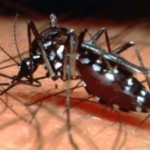Surfing legend Andy Irons dies

Andy Irons, a three-time world champion surfing legend, has died. The 32 year old Hawaiian native was found dead in a hotel room in Texas yesterday. Irons was currently being treated for dengue fever. According to the Honolulu Star Advertiser: “His death is being investigated as a possible overdose of methadone, according to the Tarrant County Medical Examiner’s Office. An autopsy is scheduled for tomorrow but the exact cause of death may require a toxicology test, which could take 60 to 90 days to complete. ” Methadone is a potent pain killer.
What is Dengue Fever? (Source: NIAID)
Dengue fever is an infectious disease carried by mosquitoes and caused by any of four related dengue viruses. This disease used to be called “break-bone” fever because it sometimes causes severe joint and muscle pain that feels like bones are breaking, hence the name. Health experts have known about dengue fever for more than 200 years.
Dengue fever is found mostly during and shortly after the rainy season in tropical and subtropical areas of
- Africa
- Southeast Asia and China
- India
- Middle East
- Caribbean and Central and South America
- Australia and the South and Central Pacific
An epidemic in Hawaii in 2001 is a reminder that many locations in the United States are susceptible to dengue epidemics because they harbor the particular types of mosquitoes that transmit dengue virus.
Worldwide, 50 to 100 million cases of dengue infection occur each year. This includes 100 to 200 cases in the United States, mostly in people who have recently traveled abroad. Many more cases likely go unreported because some health care providers do not recognize the disease.
During the last part of the 20th century, many tropical regions of the world saw an increase in dengue cases. Epidemics also occurred more frequently and with more severity. In addition to typical dengue, dengue hemorrhagic fever (DHF) and dengue shock syndrome also have increased in many parts of the world. Globally, there are an estimated several hundred thousand cases of DHF per year.
 Cause
Cause
Dengue fever can be caused by any one of four types of dengue virus: DEN-1, DEN-2, DEN-3, and DEN-4. You can be infected by at least two if not all four types at different times during your lifetime, but only once by the same type.
Transmission
You can get dengue virus infections from the bite of an infected Aedes mosquito. Mosquitoes become infected when they bite infected humans, and later transmit infection to other people they bite. Two main species of mosquito, Aedes aegypti and Aedes albopictus, have been responsible for all cases of dengue transmitted in this country. Dengue is not contagious from person to person.
 Symptoms
Symptoms
Symptoms of typical uncomplicated (classic) dengue usually start with fever within 4 to 7 days after you have been bitten by an infected mosquito and include
- High fever, up to 105ºF
- Severe headache
- Retro-orbital (behind the eye) pain
- Severe joint and muscle pain
- Nausea and vomiting
- Rash
The rash may appear over most of your body 3 to 4 days after the fever begins, and then subsides after 1 to 2 days. You may get a second rash a few days later.
Symptoms of dengue hemorrhagic fever include all of the symptoms of classic dengue plus
- Marked damage to blood and lymph vessels
- Bleeding from the nose, gums, or under the skin, causing purplish bruises
- This form of dengue disease can cause death.
Symptoms of dengue shock syndrome-the most severe form of dengue disease-include all of the symptoms of classic dengue and dengue hemorrhagic fever, plus
- Fluids leaking outside of blood vessels
- Massive bleeding
- Shock (very low blood pressure)
- This form of the disease usually occurs in children (sometimes adults) experiencing their second dengue infection. It is sometimes fatal, especially in children and young adults.
Diagnosis
A health care provider can diagnose dengue fever by doing two blood tests, 2 to 3 weeks apart. The tests can show whether a sample of your blood contains antibodies to the virus. In epidemics, a health care provider often can diagnose dengue by typical signs and symptoms.
Treatment
There is no specific treatment for classic dengue fever, and most people recover within 2 weeks. To help with recovery, health care experts recommend
- Getting plenty of bed rest
- Drinking lots of fluids
- Taking medicine to reduce fever
- Centers for Disease Control and Prevention advises people with dengue fever not to take aspirin. Acetaminophen or other over-the-counter pain-reducing medicines are safe for most people.
For severe dengue symptoms, including shock and coma, early and aggressive emergency treatment with fluid and electrolyte replacement can be lifesaving.
Prevention
The best way to prevent dengue virus infection is to take special precautions to avoid being bitten by mosquitoes. Several dengue vaccines are being developed, but none is likely to be licensed by the Food and Drug Administration in the next few years.
When outdoors in an area where dengue fever has been found
- Use a mosquito repellent containing DEET, picaridin, or oil of lemon eucalyptus
- Dress in protective clothing—long-sleeved shirts, long pants, socks, and shoes
Because Aedes mosquitoes usually bite during the day, be sure to take precautions, especially during early morning hours before daybreak and in the late afternoon before dark.
Other precautions include
- Keeping unscreened windows and doors closed
- Keeping window and door screens repaired
- Getting rid of areas where mosquitoes breed, such as standing water in flower pots, containers, birdbaths, discarded tires, etc.
Complications
Most people who develop dengue fever recover completely within 2 weeks. Some, especially adults, may be tired and/or depressed for several weeks to months after being infected with the virus.
The more clinically severe dengue hemorrhagic fever and dengue shock syndromes can result in vascular (blood vessel) and liver damage, and can be life-threatening.



























0 comments